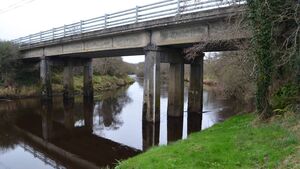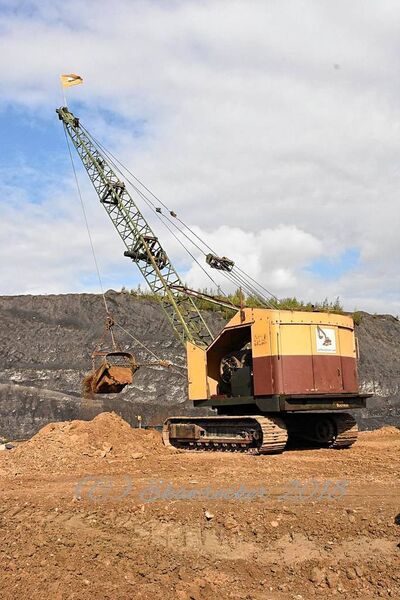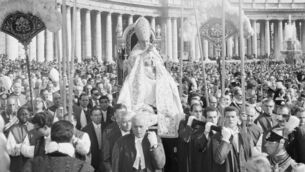Much was lost with the draining of the Moy

The bridge at Cloonacanna, Swinford, that replaced the old structure dating back to the 1880s.
The draining of the river Moy, which was carried out during the 1960s and early 1970s, was a project that was both welcomed and resented in equal measure by those most effected by the scheme.
The drainage work involved the dredging of the main channel of the river, and its tributaries, from Ballina to Cloonacool in Co Sligo. This work was carried out by powerful machinery, the likes of which had never been seen in the West of Ireland before that time.
People along the river quickly became accustomed to the giant machines. The 22RB was the most commonly used but bigger jobs and wider stretches of the river often demanded the use of the much larger 54RB. RB standing for Ruston-Bucyrus, a company which then manufactured a range of earthmovers and dredgers at its plant at Lincoln in England. These machines had a simple mechanical system operated by levers, pulley wheels and steel ropes – thus the name, dragline - and they drank deiseal like there was no tomorrow.
All of these machines were mounted on crawler tracks, but along marshy river banks, not even these tank-like tracks could keep the machines afloat. A series of massive wooden mats were then put in place in front of the machines, allowing them to crawl along as they deepened the river bed below. These mats resembled a pallet made from giant planks, planks that were often covered with every imaginable contaminant.

On a wet day, and there were many wet days, as the invasion force moved slowly upriver, the scene was often reminiscent of a World War II battlefield. Clearing the way for the main attack, a small advance infantry battalion (and my father was one of these), would disconnect the old barbed wire fences that were strung along between field and river. The giant crane then lumbered along, placing in its path the necessary matting to prevent it from sinking or sliding into the river. When dredging work was in progress, the river was frequently inundated with a runoff cocktail that included oil, diesel and liquid earth.
A small platoon of soldiers attended the progress of the Ruston-Bucyrus as it chewed and pivoted and spewed. Soft opposition made for steady progress in the fight to tame the Moy but the drainage army regularly encountered stiff resistance from bedrock. This necessitated calling in the explosive experts. New words arrived into our local lexicon: compressor, drill-hole, gelignite, detonator, fuse wire, blast. New games were invented by local children, who each evening discovered empty detonator shells, plastic-coated wire and incomplete drill holes. If the constant dredging and the contamination from runoff hadn’t destroyed most of the ancient fish stock in the river, the massive explosions required to blast out the new river bed surely stunned the remainder into oblivion.
Some parts of the river were simply dredged to a lower level but in other places, where bends had previously been the cause of flooding, the river was straightened. This meant breaking new ground. Such canal-like creations tore up huge tracts of land and often annexed precious little fields, some land being lost entirely. A good field might be halved or replaced with the worthless, artificial ox bows of the old river bends. While these wastelands did make suitable homes for nesting wild duck, they also became swallow holes for unsuspecting cows.
While it was envisaged in the original drainage plan that the huge amounts of soil excavated as part of the project were to be spread on the adjacent land, this was seldom done. Massive mounds of spoil remain along the riverbank to this day. But when those mounds were newly formed, they created a wonderland. Formed mostly of clay and daub, these piles refused any form of vegetation for months, maybe years. When baked in summer heat, they formed a Wild West landscape that invited countless cowboy and Indian adventures. These were the days of and and on most July evenings, local children were presented with their abandoned film sets. When thrown at force, the small clods of hard daub exploded on impact, resembling the ricochet of a stray bullet and the top of each mound was a position of commanding authority, not relinquished easily.
At a time in our existence when it is almost necessary to get an environmental impact statement if you want to have a decent sneeze, it is difficult to imagine such a scheme ever taking place today. At a time when grants are being paid for rewilding margins along rivers and rewetting areas of bogland, one wonders what if anything was gained from draining the Moy. Certainly, there was some financial gains for farmers, my own father included, but little thought was given to the long-term impact on wildlife, fish stocks and antiquities.
When Rev. James Greer wrote his series of essays and published his book, , over 100 years ago, he followed the trail of the Moy in its original and pristine state. He refers in his writing to the bridge at Cloonacanna, near Swinford. The beautiful old bridge was a casualty of the drainage scheme, only an isolated pier remains to mark the past architectural glory of the bridge, a steel structure built in Scotland. The following is Greer’s memory of the bridge, which he observed on a walk he undertook between Banada and Swinford in June 1918.
We lived beside Cloonbaniff Bridge, at the Cloonacool end of the river, near its source. As a nine-year-old, the scheme also gave me my first job; each summer morning at 10 O’clock, I brought my father his daily snack.
Arriving at the bridge, which was being rebuilt, was like entering a 19th century railway worker’s camp. A fire kindled by the roadside, lit with oil-soaked rags and fuelled with diesel-soaked timber. The chief cook and bottle washer was another local man who walked, first thing each morning, to the local well for fresh water. His was yet another job created by the scheme. When his giant black kettle finally came to the boil, ten or twelve workmen soon gathered round. These men were all strangers to me but my father would talk about them at night, mentioning such faraway places as Bonniconlon and Swinford and Crossmolina.
The job my father had on the river was short-lived – he only worked there for two nine-month periods, but he loved it. He loved the experience of being with other men, of hearing new stories and, of course, there was the weekly wage. He was paid in cash each Friday morning and I remember the evening he came home proudly brandishing a huge red £20 note, his week’s wages. He was the happiest man… and why wouldn’t he be, and him being paid while his land was being drained free of charge. Whatever about anything else, his fields along the River Moy never flooded again.





